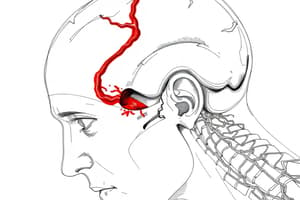Podcast
Questions and Answers
During the trauma nursing process, which of the following assessments is NOT typically part of the initial 'A' (Alertness and Airway) assessment?
During the trauma nursing process, which of the following assessments is NOT typically part of the initial 'A' (Alertness and Airway) assessment?
- Glasgow Coma Scale (correct)
- Assessment of airway patency
- Maintenance of cervical spinal stabilization
- AVPU (Alert, Verbal, Pain, Unresponsive) scale
According to the Trauma Nursing Process, what should be done immediately after assessing the patient's level of alertness and airway?
According to the Trauma Nursing Process, what should be done immediately after assessing the patient's level of alertness and airway?
- Assess pupils
- Assess breathing effectiveness (correct)
- Obtain blood glucose
- Remove clothing to assess for injuries
When assessing 'C' (Circulation) during the primary survey, which of these is an important assessment point?
When assessing 'C' (Circulation) during the primary survey, which of these is an important assessment point?
- Assessing the patient's pupils
- Assessing pain level
- Assessing for the presence of a naso- or orogastric tube
- Anticipating goal-directed therapy for shock (correct)
In what order should the assessments indicated with double stars be completed during the primary survey?
In what order should the assessments indicated with double stars be completed during the primary survey?
Which of the following is part of the 'E' (Exposure and Environmental Control) assessment?
Which of the following is part of the 'E' (Exposure and Environmental Control) assessment?
During secondary survey, which of the following is part of the 'H' (History and Head-to-Toe) assessment?
During secondary survey, which of the following is part of the 'H' (History and Head-to-Toe) assessment?
The 'I' step of the secondary survey involves:
The 'I' step of the secondary survey involves:
Following the primary and secondary surveys, what is a critical step in the ongoing trauma nursing process?
Following the primary and secondary surveys, what is a critical step in the ongoing trauma nursing process?
Flashcards
Primary Survey
Primary Survey
The initial assessment process in trauma care that prioritizes life-threatening conditions. It is divided into a series of steps to identify and address immediate threats to the patient's airway, breathing, circulation, disability, and exposure.
A: Airway
A: Airway
This step in the Primary Survey focuses on assessing the patient's level of consciousness and ensuring the airway is open and patent (clear). This includes stabilizing the cervical spine to prevent further injury.
B: Breathing
B: Breathing
This step in the Primary Survey focuses on assessing the patient's breathing effectiveness and ventilation. It involves assessing the rate, depth, and rhythm of breathing, as well as the presence of any distress or difficulty breathing.
C: Circulation
C: Circulation
Signup and view all the flashcards
D: Disability
D: Disability
Signup and view all the flashcards
E: Exposure & Environment
E: Exposure & Environment
Signup and view all the flashcards
Secondary Survey
Secondary Survey
Signup and view all the flashcards
H1: History
H1: History
Signup and view all the flashcards
Study Notes
Trauma Nursing Process (TNP)
- Preparation and Triage:
- Activate trauma team and assign roles
- Prepare treatment room and specialized equipment
- Don Personal Protective Equipment (PPE), consider safety threats to team or decontamination needs
- General Impression:
- Assess for uncontrolled hemorrhage, unresponsiveness/apnea, and need to reprioritize C-ABC
- Primary Survey (A-G):
- A Alertness (A1) and Airway (A2):*
- Maintain cervical spinal stabilization
- Use AVPU (Alert, Verbal, Pain, Unresponsive) scale
- Assess airway patency at least four times
- B Breathing and Ventilation:
- Assess breathing effectiveness at least four times
- C Circulation and Control of Hemorrhage:
- Assess pulse, skin color/temperature/moisture
- Anticipate goal-directed therapy for shock
- D Disability (Neurologic Status):
- Use Glasgow Coma Scale
- Assess pupils
- Obtain blood glucose if altered mental status
- E Exposure (E1) and Environmental Control (E2):
- Remove clothing, provide warmth
- F Full Set of Vital Signs (F1) and Family Presence (F2):
- Record full set of vital signs
- Assess for family presence needs
- G Get Adjuncts (G1) and Give Comfort (G2):
- Obtain necessary adjunct treatments
- Provide comfort measures
- A Alertness (A1) and Airway (A2):*
- Re-evaluation:
- Continuously re-evaluate vital signs, identified injuries, intervention effectiveness, primary assessment, and pain levels
- Secondary Survey (H-I):
- H History (H1) and Head-to-Toe (H2) Exam:
- Obtain prehospital report (SAMPLE)
- Perform head-to-toe assessment
- Inspect posterior surfaces unless contraindicated by suspected spine or pelvic injury
- H History (H1) and Head-to-Toe (H2) Exam:
- Anticipated Interventions or Diagnostics:
- Perform at least three anticipated interventions or diagnostics
- Transfer or Definitive Treatment:
- Re-evaluate for transfer or preparation for definitive treatment
Studying That Suits You
Use AI to generate personalized quizzes and flashcards to suit your learning preferences.




